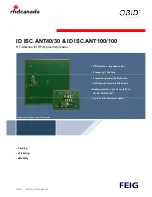
5.1 Excitation voltage
When determining the excitation voltage, it is important to consider the maximum excitation
current the sensor can experience without self-heating. This is typically less than 0.35 mA. Refer
to the manufacturer's data sheet for the sensor for the specific value.
Once the maximum excitation current is known, the excitation voltage is then calculated.
V
x
= I
x
(R
1
+ R
Smax
+ R
f
)
Where:
R
1
= 10 kΩ, the current limiting resistor in the terminal input module
R
Smax
= Maximum sensor resistance based on the maximum expected temperature to be
measured
R
f
= PRT completion resistor value
Using the typical 0.35 mA maximum excitation current, the maximum excitation voltage for the
sensor is:
4WPB100
V
x
= 0.35 mA (10,000 Ω + 125 Ω + 100 Ω) = 3579 mV
4WPB1K
V
x
= 0.35 mA (10,000 Ω + 1250 Ω + 1000 Ω) = 4290 mV
Small variations in sensor resistance do not cause significant differences in the calculated
maximum excitation voltage. For example, changing the sensor resistance to 84 Ω when used
with the 4WPB100 reduces the maximum excitation from 3579 mV to 3564 mV.
5.2 Calibrating a PRT
The greatest source of error in a PRT is likely to be that the resistance at 0 °C deviates from the
nominal value. Calibrating the PRT in an ice bath can correct this offset and any offset in the
fixed resistor in the terminal input module.
The result of the 4 wire half bridge is:
With the PRT at 0 °C, R
s
=R
0
. Thus, the above result becomes R
0
/R
f
, the reciprocal of the
multiplier required to calculate temperature, R
f
/R
0
. By making a measurement with the PRT in an
ice bath, errors in both R
s
and R
0
can be accounted for.
4WPB100, 4WPB1K PRT Bridge Terminal Input Modules
9




































